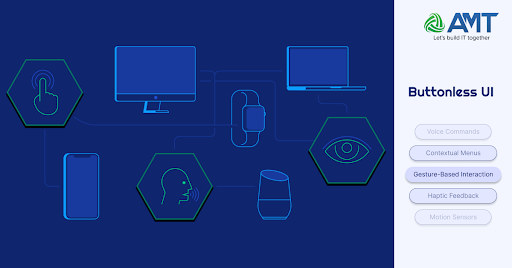A “buttonless UI” refers to a user interface (UI) design that minimizes or eliminates the use of traditional buttons in favor of alternative interaction methods. This concept has gained popularity in recent years as technology has advanced and user expectations have evolved. Here are some key aspects and considerations related to buttonless UI design:
- Gesture-Based Interaction: Buttonless UI often relies on gestures and touch-based interactions. Users can swipe, pinch, tap, or perform other gestures to navigate and interact with the interface. Gesture-based UIs are common in touchscreen devices like smartphones and tablets.
- Voice Commands: Voice-activated interfaces are another form of buttonless UI. Users can interact with the system or application by speaking commands, which are processed by voice recognition technology. Voice assistants like Siri, Google Assistant, and Amazon Alexa are prominent examples of this approach.
- Contextual Menus: Rather than displaying a fixed set of buttons, a buttonless UI may dynamically present contextual menus or options based on user actions or selections. This approach reduces clutter and simplifies the interface, making it more user-friendly.
- Haptic Feedback: To provide feedback without physical buttons, buttonless UIs often rely on haptic feedback, which includes vibrations or other tactile sensations that confirm user actions. This helps users know that their input has been registered.
- Motion Sensors: Some buttonless UIs incorporate motion sensors, such as accelerometers and gyroscopes, to enable interactions through tilting or shaking the device. For example, tilting a smartphone can change the orientation of a map or image.
- Proximity Sensors: Proximity sensors can be used to detect when a user’s hand or finger is approaching the screen, triggering specific actions or revealing additional interface elements.
- Flat Design: Buttonless UIs often feature a flat design aesthetic, which emphasizes simplicity, minimalism, and a clean visual style. This design philosophy aligns with the idea of reducing the prominence of traditional buttons.
- Usability and Accessibility: While buttonless UIs can provide a sleek and modern look, they should also prioritize usability and accessibility. Ensuring that users can easily understand and interact with the interface is crucial.
- Consistency: Maintaining consistency in buttonless UI design is essential. Users should be able to predict how interactions work throughout the application or system. Gestures and other interactions should be intuitive and well-documented.
- Testing and Feedback: Usability testing and gathering feedback from users are vital steps in developing buttonless UIs. This helps identify potential usability issues and allows for iterative improvements.
Buttonless UI designs can be effective in certain contexts, particularly on touchscreen devices where physical buttons may be limited or absent. However, it’s important to strike a balance between aesthetics and usability, ensuring that users can easily navigate and interact with the interface without feeling confused or frustrated.
Here are some additional considerations and examples related to buttonless UI:
- Adaptive Interfaces: Buttonless UIs can adapt to different devices and screen sizes. Responsive design techniques ensure that the user experience remains consistent and optimized, whether on a smartphone, tablet, desktop, or other platforms.
- Feedback and Affordances: Buttonless UIs should provide clear feedback and visual affordances to guide users. For example, highlighting interactive elements when users hover over them or providing subtle animations can help users understand where and how to interact.
- Progressive Disclosure: Progressive disclosure is a design principle where complex or less frequently used options are hidden by default but can be revealed when needed. This helps reduce clutter and cognitive load in buttonless UIs.
- Multi-Touch Gestures: On touch-enabled devices, multi-touch gestures can enhance user interactions. For example, pinching and spreading fingers can zoom in and out of images or maps, and swiping with multiple fingers can trigger different actions.
- Customization Options: Allowing users to customize gestures or assign functions to specific gestures can improve the user experience. This empowers users to tailor the interface to their preferences and needs.
- Accessibility Features: Consider accessibility features such as voice commands, screen readers, and alternative input methods for users with disabilities. Ensuring that buttonless UIs are inclusive is essential.
- Virtual Keyboards: On devices without physical keyboards, virtual keyboards are often part of the buttonless UI. These keyboards can adapt to different languages and input methods.
- Gaze and Eye Tracking: In some specialized applications and emerging technologies, gaze and eye tracking can be used as input methods, allowing users to interact with the interface by looking at specific elements on the screen.
- Wearable Technology: Wearable devices like smartwatches often use buttonless UIs due to their small screen sizes. Swiping, tapping, and voice commands are common interaction methods on wearables.
- Future Innovations: Buttonless UIs are continuously evolving with advancements in technology. Concepts like brain-computer interfaces (BCIs) and augmented reality (AR) glasses may introduce entirely new ways of interacting with digital interfaces in the future.
- Education and Onboarding: To ensure that users understand how to interact with a buttonless UI, it’s important to provide clear onboarding processes and tutorials. Users should feel comfortable and confident using the interface from the start.
- Consistency Across Platforms: If your application or service is available on multiple platforms (e.g., iOS, Android, web), strive for consistency in the buttonless UI to provide a unified experience to users across different devices.
- User Testing: Continuously gather user feedback and conduct usability testing to identify pain points and areas for improvement in the buttonless UI. This iterative approach can lead to refinements that enhance user satisfaction.
Buttonless UI design is a dynamic field that continues to evolve with technology and user expectations. As designers and developers explore new interaction methods and technologies, the goal remains the same: to create intuitive, user-friendly interfaces that prioritize ease of use and accessibility.
Above is a brief about Buttonless UI. Watch this space for more updates on the latest trends in Technology.
